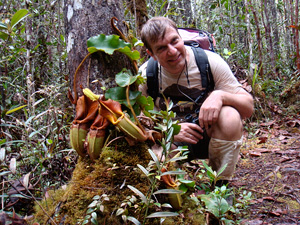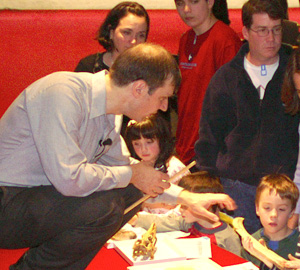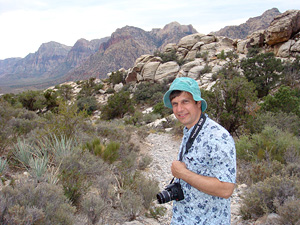 PaleoPeople PaleoPeople
Charles Marshall
University of California, Berkeley, Berkeley, CA, USA
— Interview conducted August, 2011
Dr. Charles Marshall is a paleobiologist, Professor in Integrative Biology at the University of California, Berkeley, and Director of the University of California Museum of Paleontology. He came to Berkeley in 2010 after serving 10 years as Professor in two departments, and as a Curator in the Museum of Comparative Zoology, at Harvard University. Before that he served eight years at UCLA. He spent two years as an NIH postdoc with Rudy Raff at Indiana University, having completed his graduate work at the University of Chicago, and undergraduate at the Australian National University, majoring in paleontology, zoology, mathematics, with minors in physical chemistry and history. He has very broad interests, including the major events in the history of life, quantification of the incompleteness of the fossil record, and integrating molecular phylogenetic and paleontological data in studying the history of life and the processes that have shaped it. |
 |


Can you have a rainforest where the underlying rock has no nutrients and doesnít hold water? Here's one: the remarkable Kerangas heath forest growing on pure glass-quality white sand, Maliau Basin, Sabah, Borneo. Photo courtesy of Charles Marshall.
|
Q: How is paleontology relevant in today's world?
To understand what's likely to happen in the future we need to understand what has happened in the past, and what caused it. And in this time of rapid global change we need to understand what is likely to happen in the future more than ever. The study of the past offers the only way of rigorously testing models of future change — when those models are run backwards in time, we can make predictions of what the past would have been like, which we can then test against the historical and fossil records.
Q: How did you end up becoming a paleontologist?
It was a round-about route. It started when I was 4 or 5, when I became addicted to dinosaurs. I had a diorama I made inside a shoebox — dinosaurs and pterosaurs with volcanoes erupting in the background. I would stare into the Mesozoic world mesmerized! And there was a volcano visible from my house — a very extinct Devonian volcano, but a volcano nonetheless. So I put two and two together and realized there were probably dinosaurs in my backyard once —the fact that the very world I lived in once upon a time looked like my little diorama just blew my anastomosing little grey cells — I was hooked. And then my path took many diversions, especially in the direction of mathematics and astronomy, but as an undergraduate, I finally was able to do paleontology at an advanced level (the early years of the journal Paleobiology were particularly stimulating), and so at that time I returned to my first love, paleontology.
Q: Was there any person in particular who influenced your development as a scientist, in general, or as a paleontologist, in specific?
As a scientist the most important by far was my father. He was an academic engineer and my scientific training — it wasn't formal — started as soon as I could talk. Being an engineer, my father often made me build and test things. There was a constant interaction between asking questions, doing exercises, often failing, and learning from the whole process. My father is an extreme lateral thinker. I'd present him with what I'd say was "the solution" to a problem and he'd say "What sort of lateral thinker are you? What do you mean the solution?" And then he would typically show me multiple ways of solving the problem. I learned how to do science well before I hit any other mentor who knew how to do it. And I had a high school teacher, Richard Sculthorp, who was particularly important in teaching me how to think properly about physics and astronomy, and then my undergraduate professors — David Brown, the charismatic K.S.W. Campbell, and Richard Barwick — all helped knock me into shape, but also helped me find my own paleobiological voice. And then of course, the amazing faculty at the University of Chicago, especially Dave Raup, were deeply formative.


Learning from the audience after a public lecture at the Harvard Museum of Natural History. Photo courtesy of Charles Marshall.
|  |
Q: What is your area of expertise and what is it about this particular area of paleontology that fascinates you?
I'm drawn to hard problems, especially questions concerned with the understanding of major evolutionary transitions and the factors that control evolutionary innovation, patterns of diversification, origination and extinction, and in how to make the most use of advances in modern biology, from ecological theory to molecular phylogenetics and genomics. My favorite taxa are echinoderms; and sarcopterygians, especially lungfish.
Q: What are some of the research projects you have worked on?
I gravitate toward inventing tools for analytic approaches that will change the way we think about hard problems. Like what is the pattern of extinction at a mass extinction boundary — is it really gradual or is it just the incompleteness of the fossil record? Also, I became frustrated with morphological analysis of evolutionary relationships which were then used to make deductions about the path of evolution — it felt like there was a degree of circularity in it. So, I wanted to try to understand the developmental basis of morphology as a way of weighting characters — that turned out to be a dreadful idea — and so I finished up trying to infer relationships using data from the genome, which is largely independent of the morphological innovations I was interested in explaining. So I've done a lot of molecular phylogenetics. You often don't make progress in paleobiology unless you bring something new to the table so I've enjoyed trying to bring developmental biology, molecular phylogenetics, and analytic techniques to my paleobiology.
Q: What problem(s) or question(s) are you currently working on? What attracted you to this problem?
One of them is using the fossil record to test the predictive power of global change models. Another involves trying to understand what information you can and cannot get out of molecular phylogenies for making inferences about diversity dynamics — the genome is a huge repository of historical information, and we are still learning how to properly tap into that information for making rigorous inferences about the past.
Q: What would you say is the most exciting and/or interesting thing that has happened to you during your career in paleontology?
There were really two. One was coming here [to UCMP] and the other was going to the University of Chicago for grad school. At Chicago there were so many amazing people unashamedly excited about paleobiology in an open intellectual environment. I grew in so many ways that were unimaginable to me before I moved to Chicago. And here, in UCMP, there is such strength in paleontology, and for the first time in my career, my primary appointment is in a biology department (Integrative Biology), and Iíve not learned so much since graduate school. Being at Berkeley is a very exciting time for me!
 |


A cool day on the Keystone Thrust, Red Rock Canyon, Nevada — it was only 108įF. Iím standing on the Cambrian, which overlies Jurassic desert sands (the red in the mountains on the horizon). Photo courtesy of Charles Marshall.
|
Q: What is a "typical" day like for you?
Each day is very different. There's a great deal of work with grants for the museum and for the Berkeley Initiative for Global Change Biology. I'd just say a mixture of research, teaching, reviewing manuscripts, meeting with students, writing letters of recommendation, and dealing with museum issues, from administration, to future directions, to grant writing.
Q: What advice would you give young people interested in becoming paleontologists?
Number one: you gotta love it. I received some good advice from a professor (a geologist) around the time I decided to switch from astronomy/physics to geology/paleo as an undergraduate. He said that advances in paleontology and geology usually come from outside those fields even though the data and the observations come from within, so make sure you get a proper grounding in the sciences — mathematics, physics, chemistry — and don't wait. Today, as paleontology is becoming increasingly biological, I would advise a better balance of biological skills and knowledge than the advice I was given, from genomics, molecular phylogenetics, development, functional morphology, evolution and ecology. Do this early — get your basic skill set down (you canít do it all, so be selective). Develop as many skills as you can that's realistic. Be adventurous, take risks. But most of all, have fun!
|



